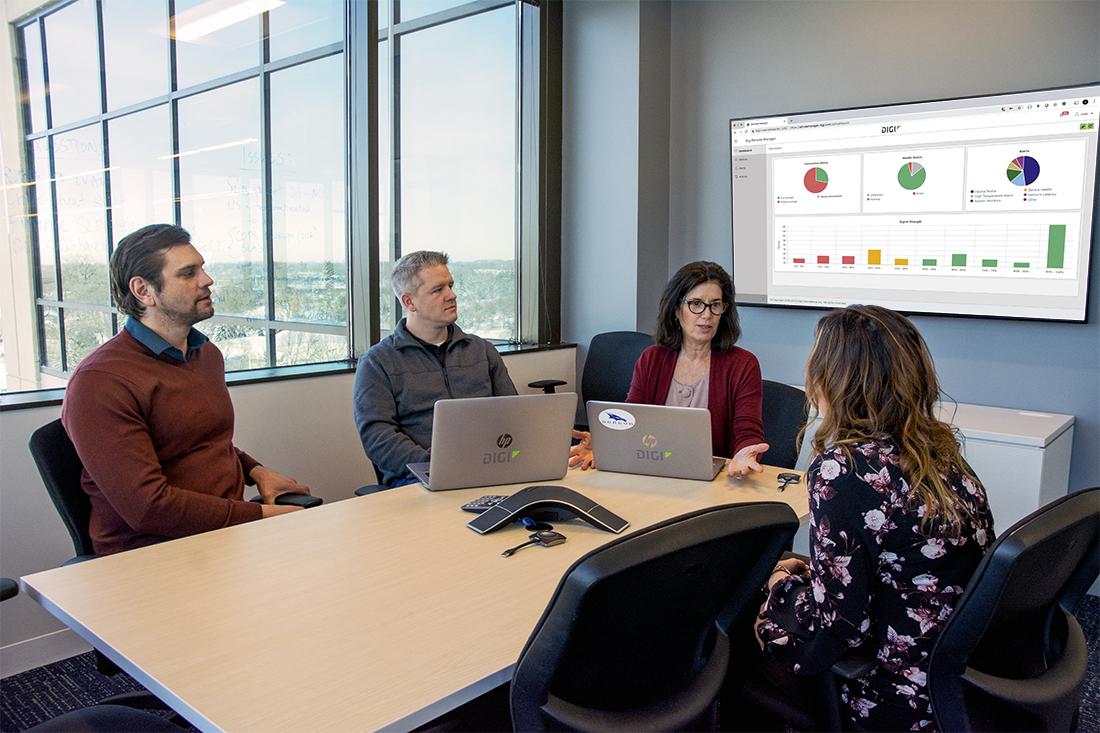With the explosive growth of the Internet of Things (IoT) in virtually every industry, network managers and IoT administrators are becoming hard pressed to manage their deployments at scale. They’re realizing that routine maintenance and security patching needs to be streamlined, so that IT staff can focus their energies on the operational functions of their IoT deployments. For that reason, more and more of these professionals are turning to “zero-touch” device configuration and remote management.
Zero-touch configuration is the process of configuring IoT devices and pushing updates out to the network from a central location. As the term implies, zero-touch configuration enables IT teams to configure, or modify, hundreds or even thousands of devices remotely. It is an alternative to configuring devices one at a time, typically on-site, as they are installed.
This method of configuring devices with their required functionality is not only faster, but provides greater consistency and uniformity in device configuration and substantially improves operational efficiencies. The benefits are profound, from reduction in costs to far fewer human errors. And if you're launching a mission critical or time-sensitive deployment, speed is of the essence.
Digi Remote Manager: The Tool for Zero Touch, Rapid Configuration
.jpg?lang=en-US)
For organizations using Digi IoT devices, zero-touch configuration begins with
Digi Remote Manager® (Digi RM) the cloud-based solution that automates the configuration process, from initial provisioning of new devices, to ongoing firmware updates, to updating the unique configurations of individual devices. We consider it an indispensable component of any Digi IoT deployment.
There are only a few simple requirements to connect devices to Digi RM and enable zero-touch configuration.
- First, you need a Digi RM account — we offer trial accounts for Digi RM for you to test zero-touch configuration and remote management.
- Second, you’ll need to ensure your device can connect to Digi RM.
- Lastly, you will need a working configuration in Digi RM’s Configuration Manager tool.
How Zero Touch Configuration Works with Digi Remote Manager
When a device is powered up and connected to the Internet, it will reach out to connect to Digi RM. Digi RM will then query the router for the type of device and then check for a matching configuration in Configuration Manager. The only prerequisite is having a configuration that is targeted for the device’s type and group.
A device group is a function for sorting devices in your Digi RM account, which is an indispensable feature as your device count grows. Naming, tagging, and search features help to ensure you can always find, manage, and monitor any device in your deployment, even it grows to thousands of devices.
It’s important to note that a device can be added to Digi RM before it is powered up and placed into a group. The Configuration Manager tool starts the process as soon as the device connects for the first time and manages the update process. Configuration Manager can check and update firmware, settings, and/or files that exist in the filesystem. Updating the configuration only takes a few minutes, while firmware updates can take 10-15 minutes based upon the device's connection, especially over cellular.
See the Configuration Manager video to learn more about this key feature of Digi RM:
Zero Touch Configuration Use Cases
Digi has supported the deployment of cellular applications of every size. Along the way, we have "seen it all." Each organization has specific needs, requirements, timelines and specific challenges. In this section we will talk about some of the many situations where having a strategy and methodology for rapidly configuring and deploying devices is critical to success, scalability and cost management.
Configuring Groups and Customizing Devices: Traffic Use Case

While there are usually some defaults and global configuration items that need to be applied, there can also be specific configurations that are unique to each location. That’s not unusual. For a lot of our customers, each device might have some unique settings.
With Digi RM, you can set up unique configurations that the Configuration Manager tool supports and manages, based on a group or an individual device or name.
A good example of this would be a deployment of devices on traffic signals in a large city. As you can imagine, in a series of signals along a major thoroughfare, every single intersection might have slightly different characteristics, depending on the nature of the traffic at that intersection, and consequently every single router needs a unique configuration. You can address this situation by uploading a CSV or Excel file that functions as a database of unique configuration settings. Those characteristics are then entered into the system using the Configuration Manager tool.
Yet that degree of specialization doesn’t impair your ability to do mass firmware updates. In addition, with Digi RM you get a history log, showing what was done. You gain visibility into your entire network and you can monitor the status according to whatever schedule you want and set up notifications to report on specific conditions or events. You can also map the network and see a visualization of it on a dashboard view with bar graphs, pie charts and other visual representations.
Fast Deployment and Firmware Update Use Cases
Zero-touch configuration with Digi RM can be a real game changer for organizations that want to rapidly deploy large numbers of devices in the field. It enables the organization to achieve their deployment goals, at any scale. Meanwhile, it reduces overall staff requirements and enables your technical people to make much better use of their time doing more value-added tasks.
The scale of the time savings can be enormous. Here are a few real life examples.
Example 1: Configuring thousands of devices
Let’s say you had to manually configure several thousand routers and each configuration took 20 minutes, on average. That includes enrolling the device, setting and verifying the settings, etc., which, frankly, can be pretty tedious work. Without a tool like Digi RM, you would have to manually configure every single device. Do the math and you quickly see that when you have a deployment of hundreds or thousands of devices, that's just not manageable.
Example 2: Performing thousands of firmware updates
As another example, we spoke with a water monitoring company recently about having to do firmware updates on 5,000 units. The process took them a week. With the Configuration Manager tool in Digi RM it could have been done in an hour or two. Once a configuration file is ready, it can be deployed out to any number of devices in the same group with just a few clicks.
Example 3: Staffing for a large number of device updates

As an additional example, we've seen digital signage companies that will update their signs by hiring 400 contract workers to do a USB key run to every single device and update them manually. Instead, they could do it remotely with Configuration Manager and it would be done in an hour with one or two people.
So, more efficient use of staff resources is a huge benefit here. Time is another one, because obviously this is much faster. And, as we all know staffing and time equals expense.
Example 4: New device, same configuration — automatically

Another good example of the zero-touch approach arises when you need to replace a device for whatever reason. With Digi RM, a technician can swap out the device and the same configuration will be applied automatically based on the device’s name.
Using the Name property in Digi RM and Configuration Manager’s Unique Settings files, configuration can be based upon a unique name, for example a bus number or site location, and not a specific device’s identifier. That's the beauty of zero-touch. Being able to take a new unit off the shelf and have it work perfectly in its unique position within the larger system.
If you were using the
Digi IX20 cellular router, for example, that device automatically calls out to Digi RM in the public cloud environment. In fact, for 99% of our customers, their devices are set up to connect with Digi RM right out of the box. This is true for all of the newer Digi LTE routers, like the
Digi WR54,
Digi TX54, or any device that uses the Digi Accelerated Linux (DAL) operating system, such as the
Digi EX15.
There is also a Digi RM mobile app that can walk you through the process. You scan the QR Code on the device’s box or device and it asks, “Do you want to add this to your account?” And that's it. The Digi RM mobile app is a good way to get started. As I said, it's only a few minutes to get the scan completed and the cellular connection up. That’s how quickly it can happen.
Zero-Touch Configuration Is for Any Industry

The benefits of zero-touch configuration aren’t limited to just a few industries or use cases with large deployments. Even for organizations that may be deploying a relatively small number of devices, it saves them a lot of trouble down the road if they can update the configurations remotely.
The truth is, whether you have 5 units or 5000, Digi RM is the way to go. If you're managing equipment and you need the ability to do firmware updates in remote locations like agricultural sites, oil platforms or other remote industrial applications, Digi RM solves that problem.
Build or Buy Remote Configuration and Management Tools?

Let's talk about the familiar “build or buy” question. Sometimes people make the costly decision to build a custom tool to perform some of these management functions, not realizing that Digi RM can already do what they need - likely at a lower cost, and with an entire devoted development team providing ongoing feature updates, security oversight and usability enhancements.
In a recent large project, the customer considered the option of building a custom tool. But after scoping out their requirements and discussing it with us, together we realized that Digi RM could do everything they needed. Using Digi RM probably saved that customer hundreds of thousands of dollars in non-recurring engineering (“NRE”) costs and maintenance.
Customers in any industry can benefit from Digi RM and more and more of them are figuring that out. They could spend a small fortune building a tool or they can use Digi RM, which we are constantly improving and refining, for a fraction of the cost. Ultimately, every customer should know that Digi RM supports Digi equipment better than any other tool. Our products definitely talk to each other well.
Digi Professional Services — Here When You Need Us

In that context, I’d like to mention that Digi Professional Services are available to help any customer, if needed. Different customers have different needs and priorities. That may involve writing custom applications, router automation scripts, or making sure that everything is set up correctly for your unique requirements.
We can help with implementation, specifically setting up zero-touch configuration and tailoring it to your use case. Using our internal knowledge and capabilities, we can help customers go live with their deployments faster. The service aspect can be very beneficial, especially if it’s a large network or if it’s the first time an organization is implementing Digi equipment.
Digi Professional Services augments the complete set of resources at your disposal, including the
Digi Remote Manager User Guide, which offers complete instructions on how to set up groups and subgroups, how to create configurations. Our customers turn to our Professional Services team when they need custom features such as Python, Bash, or other programming and support for edge compute functionality. We can help augment internal teams, too.
Conclusion
Fleet management with electronic equipment is always a challenge. And organizations that want to take full advantage of IoT must be able to configure their devices at scale, according to their unique business needs — with as little manual intervention as possible. Zero-touch configuration is the best way to do that, and Digi RM is the best zero-touch tool for any Digi deployment.
To learn how the latest version of Digi Remote Manager, along with Digi Professional Services, can bring the benefits of zero-touch configuration to your own deployment,
contact us or visit the
Digi Remote Manager web page.